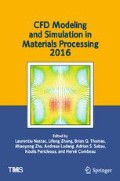Abstract
The continuous casting tundish has evolved into a useful reactor for liquid steel refining. The appreciate flow control devices such as dam, turbulence inhibitor and gas blowing, helps to modify the pattern and minimize short circuiting and dead zone. In this paper, a commercial computational fluid dynamics (CFD) package FLUENT was used to predict the flow field under steady state in one-strand tundish. The effects of flow control devices, gas bottom-blowing flow rate on flow field and residence time distribution (RTD) were studied. The results show that the molten steel flow state in optimized tundish has been improved significantly. When the gas blowing position was 1950mm from inlet axis and argon flow rate was 0.3m3/h, the average residence time of molten steel in the tundish was prolonged. And the volume fraction of dead zone in the tundish was reduced from 28.6% to 13.3%.
Access this chapter
Tax calculation will be finalised at checkout
Purchases are for personal use only
Preview
Unable to display preview. Download preview PDF.
References
Kumar A, Mazumdar D, Koria S C, “Modeling of fluid flow and residence time distribution in a four-strand tundish for enhancing inclusion removal,” ISIJ international, 48(2008), 38–47.
A. Kumar, S. C. Koria and D. Mazumdar, “An assessment of fluid flow modelling and residence time distribution phenomena in steelmaking tundish systems,” ISIJ international, 44(2004), 1334–1341.
Mazumdar D, Yamanoglu G, Guthrie R I L, “Hydrodynamic performance of steelmaking tundish systems: a comparative study of three different tundish designs,” Steel research, 68(1997), 293–300.
Lopez-Ramirez S, Morales R D, Serrano J A R, “Numerical simulation of the effects of buoyancy forces and flow control devices on fluid flow and heat transfer phenomena of liquid steel in a tundish,” Numerical Heat Transfer: Part A: Applications, 37(2000), 69–85.
Yamanaka H, “Effect of Argon Bubbling in Tundish on Removal of Non-Metallic Inclusion in Slab,” Tetsu to Hagane, 69(1983), 213–230.
Reeks M W, “On the dispersion of small particles suspended in an isotropic turbulent fluid,” Journal of fluid mechanics, 83(1977), 529–546.
Abbott M B, Basco D R, “Computational fluid dynamics-An introduction for engineers,” NASA STI/Recon Technical Report A, 90(1989), 51377.
Launder B E, Spalding D B, “The numerical computation of turbulent flows,” Computer methods in applied mechanics and engineering, 3(1974): 269–289.
Garcia-Hernandez S, Morales R D, Barreto J J, et al, “Numerical Optimization of Nozzle Ports to Improve the Fluidynamics by Controlling Backflow in a Continuous Casting Slab Mold,” ISIJ international, 53(2013): 1794–1802.
Author information
Authors and Affiliations
Editor information
Editors and Affiliations
Rights and permissions
Copyright information
© 2016 The Minerals, Metals & Materials Society
About this chapter
Cite this chapter
Liu, S. et al. (2016). Numerical Simulation of the Multiphase Flow in the Single-Tundish System. In: Nastac, L., et al. CFD Modeling and Simulation in Materials Processing 2016. The Minerals, Metals & Materials Series. Springer, Cham. https://doi.org/10.1007/978-3-319-65133-0_9
Download citation
DOI: https://doi.org/10.1007/978-3-319-65133-0_9
Publisher Name: Springer, Cham
Print ISBN: 978-3-319-65132-3
Online ISBN: 978-3-319-65133-0
eBook Packages: Chemistry and Materials ScienceChemistry and Material Science (R0)

